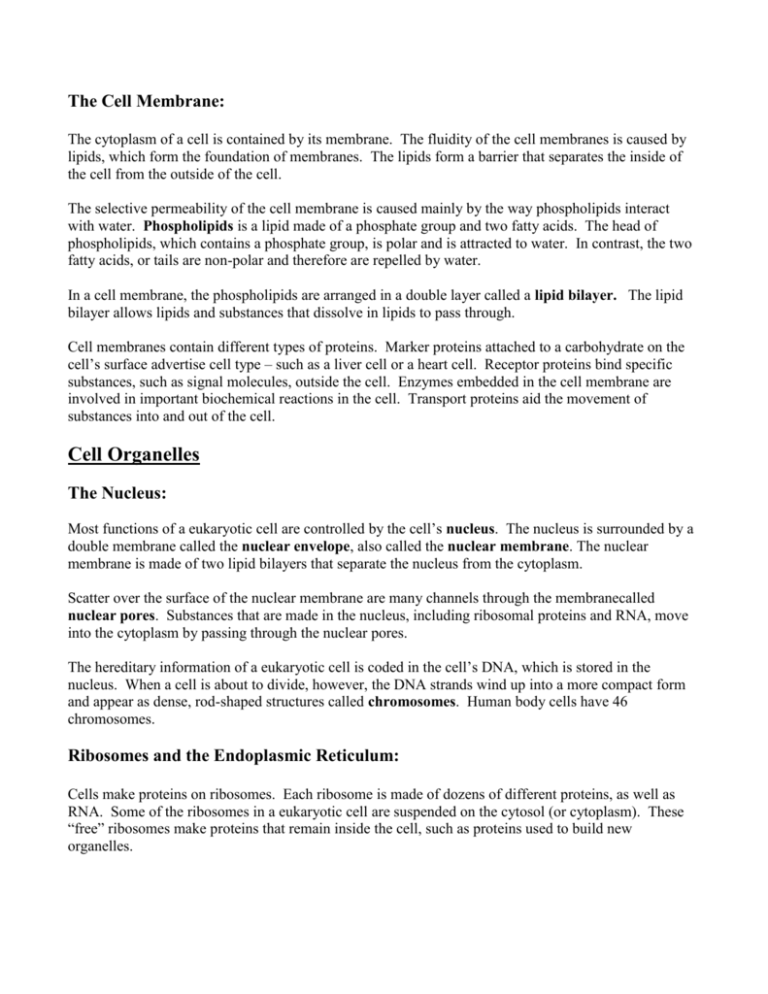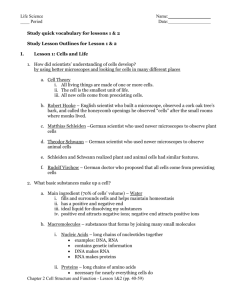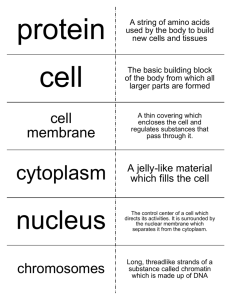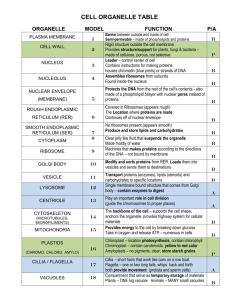The Cell Membrane:
advertisement

The Cell Membrane: The cytoplasm of a cell is contained by its membrane. The fluidity of the cell membranes is caused by lipids, which form the foundation of membranes. The lipids form a barrier that separates the inside of the cell from the outside of the cell. The selective permeability of the cell membrane is caused mainly by the way phospholipids interact with water. Phospholipids is a lipid made of a phosphate group and two fatty acids. The head of phospholipids, which contains a phosphate group, is polar and is attracted to water. In contrast, the two fatty acids, or tails are non-polar and therefore are repelled by water. In a cell membrane, the phospholipids are arranged in a double layer called a lipid bilayer. The lipid bilayer allows lipids and substances that dissolve in lipids to pass through. Cell membranes contain different types of proteins. Marker proteins attached to a carbohydrate on the cell’s surface advertise cell type – such as a liver cell or a heart cell. Receptor proteins bind specific substances, such as signal molecules, outside the cell. Enzymes embedded in the cell membrane are involved in important biochemical reactions in the cell. Transport proteins aid the movement of substances into and out of the cell. Cell Organelles The Nucleus: Most functions of a eukaryotic cell are controlled by the cell’s nucleus. The nucleus is surrounded by a double membrane called the nuclear envelope, also called the nuclear membrane. The nuclear membrane is made of two lipid bilayers that separate the nucleus from the cytoplasm. Scatter over the surface of the nuclear membrane are many channels through the membranecalled nuclear pores. Substances that are made in the nucleus, including ribosomal proteins and RNA, move into the cytoplasm by passing through the nuclear pores. The hereditary information of a eukaryotic cell is coded in the cell’s DNA, which is stored in the nucleus. When a cell is about to divide, however, the DNA strands wind up into a more compact form and appear as dense, rod-shaped structures called chromosomes. Human body cells have 46 chromosomes. Ribosomes and the Endoplasmic Reticulum: Cells make proteins on ribosomes. Each ribosome is made of dozens of different proteins, as well as RNA. Some of the ribosomes in a eukaryotic cell are suspended on the cytosol (or cytoplasm). These “free” ribosomes make proteins that remain inside the cell, such as proteins used to build new organelles. The endoplasmic reticulum, or ER, is an extensive system of internal membranes that move proteins and other substances through the cell. The part of the ER with attached ribosomes is called rough ER because it has a rough appearance. The rough ER helps transport the proteins that are made by its attached ribosomes. The portion of the ER that contains the completed protein then pinches off to form a vesicle. A vesicle is a small, membrane-bound sac that transports substances in cells. The rest of the ER is called smooth ER because it lacks ribosomes. The smooth ER performs various functions, such as making lipids and breaking down toxic substances. Packaging and Distribution of Proteins: Vesicles that contain newly made proteins move through the cytoplasm from the ER to an organelle called the Golgi apparatus, which is a set of flattened, membrane-bound sacs that serves as the packaging and distribution center of the cell. Modified proteins are enclosed in new vesicles that bud from the surface of the Golgi apparatus Some of these vesicles include lysosomes, which are small, spherical organelles that contain the cell’s digestive enzymes. Here’s how the ER, Golgi apparatus, and lysosomes produce, package, and distribute proteins: Step 1: Ribosomes make proteins on the rough ER. The proteins are packaged into vesicles. Step 2: The vesicles transport the newly made proteins from the rough ER to the Golgi apparatus. Step 3: In the Golgi apparatus proteins are processed and then packaged into new vesicles. Step 4: Many of these vesicles move to the cell membrane and release their contents outside the cell. Step 5: Other vesicles, including lysosomes, remain within the cytoplasm. Lysosomes digest and recycle the cell’s used components by breaking down proteins, nucleic acids, lipids and carbohydrates. Mitochondria: Nearly all eukaryotic cells contain many mitochondria. A mitochondrion is an organelle that harvests energy from the organic compounds to make ATP, the main energy currency of cells. Cells that have a high energy requirement, such as muscle cell, may contain hundreds or thousands of mitochondria. Structure of Plant Cells: Cell Wall The cell membrane of the plant cell is surrounded by a thick cell wall, composed of proteins and carbohydrates, including the polysaccharide cellulose. The cell wall helps support and maintain the shape of the cell, protects the cell from damage, and connects if with adjacent cells. Chloroplasts Chloroplasts are organelles that use light energy to make carbohydrates from carbon dioxide and water. Chloroplasts, along with mitochondria, supply much of the energy needed to power the activities of the cells. Central vacuole The central vacuole stores water and may contain many substances, including ions, nutrients and wastes. When the central vacuole is full, it makes the cell rigid. This rigidity enables a plant to stand upright.








